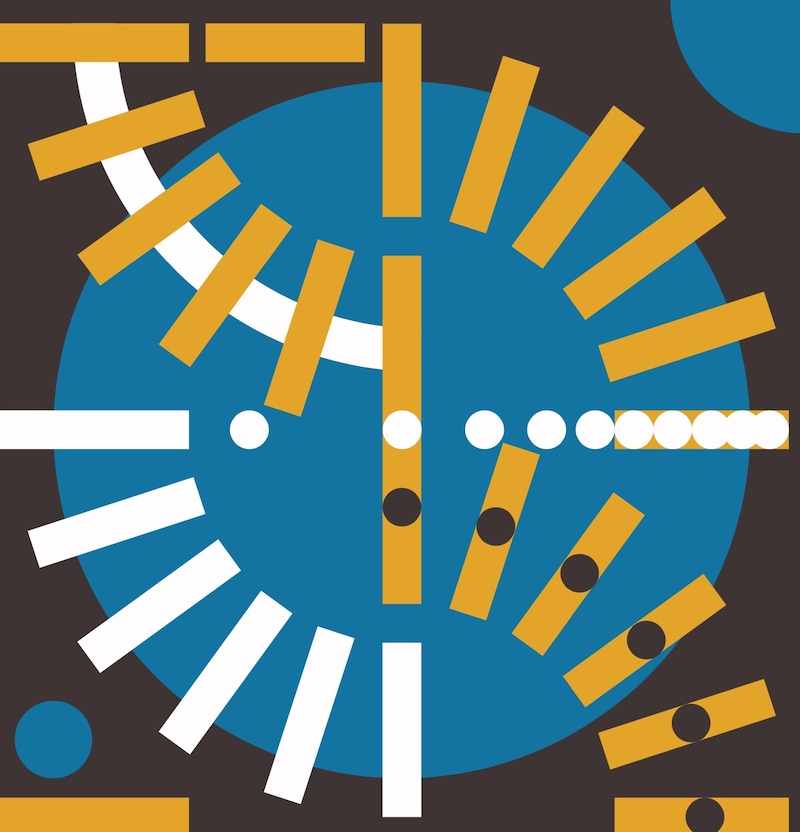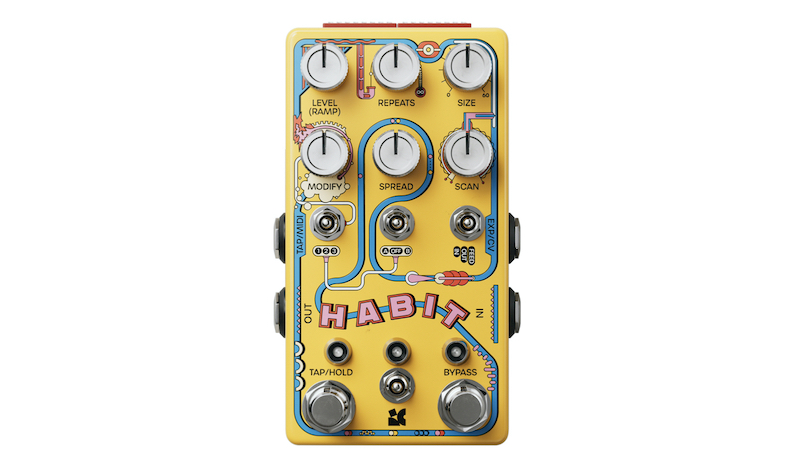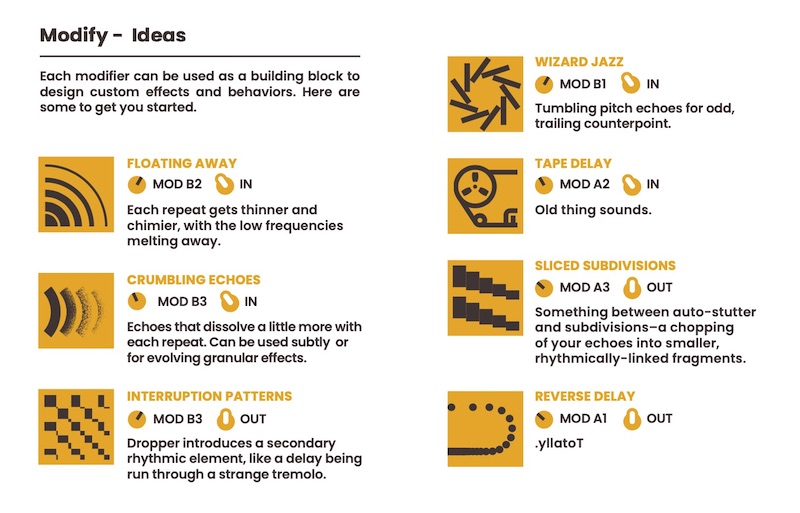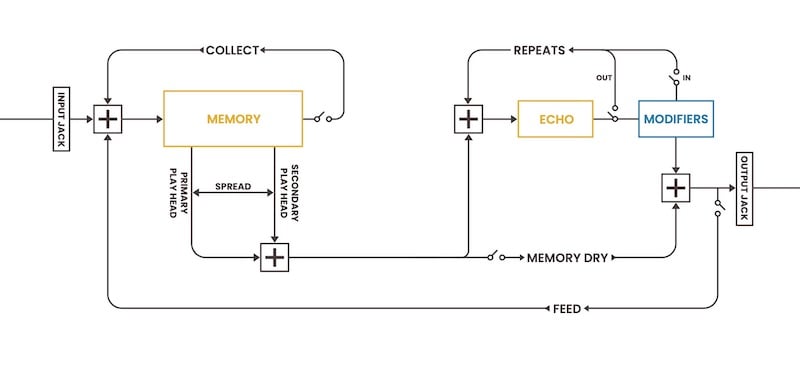Today, Chase Bliss Audio announced their brand new pedal Habit—an experimental delay pedal that pushes boundaries and challenges the very nature of how a delay pedal works and what it should be able to do. You can definitely use it like a standard delay, achieving everything from tape echo to clean multi-tap behaviors...but there's more beneath the surface than just that.
In some ways, Habit is to delays what their prior release Blooper is to looper pedals. Sure, Blooper can be a straightforward looper, but it thrives on modification of the loops, with everything from incrementally-accrued transformation of the sound all the way to nonlinear playback and unexpected sonic surprises. And in fact, Chase Bliss describes Habit as such: "At its simplest, Habit is an experimental delay that can be up to a minute long. At its extreme, it's a self-contained song made up of chance encounters. . .Habit is a delay with a memory."
But what does it mean for a delay to have a memory? What would be possible if your delay pedal could look into the distant past, and fragments of your playing (and its own processed sound) could be interjected into the present? What sort of music would you make if time could be collapsed, and you began to understand that your playing in the present would—in some unpredictable way—manifest again and again into the future?
Let's start out by talking briefly about memory. Then, we'll take a quick look at what Habit does, how it works, and how you might be able to use it.
Why Would a Delay Pedal Have a Memory?
In a sense, every delay pedal has a "memory"—after all, the nature of echo effects is that they repeat sounds from the past. The delay time determines how far into the past they reach, and the feedback control makes it such that the repeated signal is subjected to the same process of recollection...creating sounds that repeat multiple times into the future. So, what makes Habit so special in this regard?

Well, one of the most remarkable parts of Habit's inner workings is that its memory is so long. With analog delays, you're lucky to get even a second of memory (delay time)...and many digital delay pedals still cap the delay time range at as low as two to ten seconds. But Habit's memory extends much farther into the past: its hidden internal memory actually stores three minutes of your playing, making it possible to reach into the distant past to recall sounds.
Why don't more delay pedals work like this? It's not exactly a technological breakthrough to be able to record three minutes of audio and play it back...so...why don't we see this kind of thing more often? Well, this has to do partly with the nature of our own short and long-term memory and perception of rhythm. When a sound's echoes are fairly close together in time, it's clear to us that they're an extension of the sound that initiated the echo process. When they become a bit farther apart, we perceive them as having a rhythmic structure: this makes it possible to do almost counterpoint-like playing with your own sound.

But when echoes have several seconds between them, it becomes more difficult to keep track of the relationship between the input sound and the delayed output. Once they're more than 8–10 seconds apart from one another, even the best of us can no longer reliably predict when the next repetition will come around. Even if the repeats are happening at regular intervals, the connection between the source sound and the echoes doesn't feel as strong to us. And in fact, it's hard to even describe the sound as being an "echo" any longer. This is why relatively few pedals designed for "delay" or "echo" effects have relatively limited time ranges: because at a certain point, audio repetition no longer feels like an echo.
Of course, that isn't to say that longer repetition periods aren't useful. This is, of course, where digital delay processes start to feel more like looping. But "looping" as a concept generally implies a certain amount of linearity. Usually, looper pedals create a loop of a specific length, allowing you to add layers/overdub with each successive pass through the loop. The sound quality from one loop to the next is usually the same—it's really a technique that's more about building tracks by incremental layering, and not so much about manipulating time/memory.
Delay pedals, of course, don't always assume that each repeat is a pristine, identical copy of what comes before it. Echoes can degrade over time, changing in volume, tone color, pitch, and more. As such, there's a lot of gray area between what a delay pedal does and what a looper does, despite their fundamental similarities. Of course, this gray area has been explored for decades. There's Terry Riley's Time Lag Accumulation experiments— ambient experiments by Brian Eno (whose Discreet Music diagram can be seen below)—and of course, Frippertronic walls of sound by Robert Fripp himself. The gradually-degrading state of long loops/delay lines has been the center of tons of music.

Of course, the thing about that sort of music is that, while the sound quality of each repetition changes, the length of the repetitions is such that you can't necessarily keep track of where the loop "begins" or "ends." In this music, "looping" isn't about creating rhythmically-locked layers the line up perfectly. Instead, it's about the events of the past crashing into the present, creating an ever-shifting, chaotically evolving tapestry of sound resulting from the player's direct interaction with the events of the past. Equally, it's about the player developing a sense of how their present actions might manifest in the future, and adapting their playing with a level of consciousness that expands beyond paying attention to the present moment alone.
Chase Bliss doesn't reference these ideas directly in their explanations of Habit, but I think it's a useful idea to keep in mind going forward. It's important to get your head in the right place before you start time traveling.
Chase Bliss Habit: The Basics
All sound coming into Habit is recorded to a three-minute internal memory. You can read from this memory in a number of ways, and can process the reiterated sounds in a number of ways. But, much in the spirit of the pedal itself, let's start simple and build from there.

Here's a quick breakdown: Habit's top three knobs (Level, Repeats, and Size) mostly govern a standard delay-like effect. Spread is a way of adding a second "playback head," giving you an effect somewhat like a standard multi-tap delay. Modify and the three toggle switches work in tandem to add some extra effects/processes into the delay's feedback loop. Scan is one of the more idiosyncratic concepts—we'll get to that later. Let's start out, for instance, with a standard delay setting.
If you want to use Habit like a "normal" delay, here's what to do: set Modify, Spread, and Scan to their minimum values. Level is the level of the wet delay sound. Repeats is like a typical delay "feedback" control, maxing out at stable, loop-like infinite build-up. Size determines your delay time, going from 50 milliseconds (a healthy slap) up to a full minute (note that Habit doesn't produce "Doppler" style pitch shifting when changing the Size parameter). Naturally, for more typical "echo" effects, keeping Size at lower values will prove useful...but using Size to reach up to a minute into the past is already a powerful way of adding a tinge of time travel into your playing. Spread, as stated above, is a control that determines the position of a second play head relative to the first—using Size and Spread in tandem can create rhythmic delay effects or, at larger Size settings, can make it possible to grab two moments from the past an interject them into the present, like multiple loopers playing catch-up with one another.
Modify: Memories...Aren't Always Accurate
Things become more peculiar once you start introducing Modify. Here's the deal: Habit allows you to select between six Modifiers for processing the recalled sound. These are selected using the two toggles below the Modify and Spread knobs, respectively. Moreover, Habit allows you to determine where in the internal signal path the Modifiers are inserted. The toggle below Scan allows you to choose three ways to use the Modifiers: In, Out, and Feed. In the Out setting, the Modifiers process the sound of the delay at the delay line's output, producing a consistent effect controlled by the Modify knob (which changes function based on the selected Modifier). In the In setting, the Modifier is inserted in the delay's feedback loop, creating transformations that evolve more and more with each repeat. The Feed setting...is a bit different. We'll talk about that in a bit.
It's important to note that the Modify knob is always neutral in the center, and introduces different variations of the selected Modifier when turned clockwise or counter-clockwise from the center. So, what kind of Modifiers are there, and how might they play out? Well, the Modifers are called Stepped Speed, Smooth Speed, Stability, Filter, Trimmer, and Dropper.

Stepped Speed manipulates playback speed in stepped intervals, introducing fifth-and-octave-based pitch shifting (with both forward and reverse playback!!). If you set the rightmost toggle to "Out," this pitch shift will equally shift all delayed repeats by the same interval. If you set the rightmost toggle to "In," though, the speed shifting effect happens within the delay feedback loop...so each repeat will be progressively shifted more and more with each repeat. The Smooth Speed Modifier works similarly, but isn't quantized—so you can create more peculiar detuned textures, from chorusing all the way to melting, dripping repeats or psychedelic washes of echoes.
The Stability Modifier provides continuously variable wow and flutter, reminiscent of a tape delay, with the option of introducing tape-like noise or not. Filter is a highpass/lowpass filter for changing the tonal color of your repeats. Trimmer "cuts off" part of your echoes partly based on your Size setting, creating rhythmic repeats, delay subdivisions, and glitches. Dropper causes playback errors—audio dropouts that range from random to pattern-based. This can create everything from stuttery granular fade-outs to chopped-up rhythmic reinforcement.
Experimentation is encouraged...and of course, remember that setting the rightmost toggle to "Out" and "In" will produce significantly different effects. Rad.
But What About Scan and Feed?

So I know what you're wondering...what the heck do Scan and Feed do? And this is where Habit becomes a bit more mystifying. These parameters both have to do with Habit's deep internal memory and how it is recalled. The thing is, there are several ways of recalling data from Habit's internal memory, and the delay-based functions we've discussed so far are only part of it.
So what is Scan? Scan is a way of allowing Habit to reach even further into the past, and to decide when/how it "remembers." There are two modes for Scan, selectable via rear-panel DIP switch: Manual and Auto. In Manual mode, the Scan knob is like a time offset, allowing you to reach back up to a full three minutes into the past. This is sort of like a pre-delay that takes effect before the "size/repeats" delay line itself. The other setting is Auto—a setting where you grant Habit the ability to decide where in its memory it wants to recall audio from. The Scan knob in this situation determines how frequently the "scanning" function occurs. At lower values, it will act like a normal delay and periodically wander off farther into the past; at higher values, it will scan constantly, blending together an unpredictable combination of sounds from the three minutes before the present. There are other options for momentarily engaging Scan using a "ramp" as well...but this article isn't going to be long enough for us to cover everything. Just know that there are a heck of a lot of ways of remembering the past.

Here's an important thing to understand: by default, Habit's echo/delay settings and Modifiers only affect the sound that is presently being recalled from memory, but do not affect the memory itself. The internal memory simply "remembers" the most recent three minutes of your playing: it listens to the sound coming into the input jack alone. There are a couple of ways to work around this. The first is by activating the Collect setting via the rear-panel DIP switches. When Collect is engaged, the Memory both records your incoming sound and re-prints onto itself continually. The memory duration itself is only three minutes long, but once you've played longer than that, the internal memory begins to overdub on itself...sort of like a looper!
The other way to mess with Habit's memory is to set the rightmost toggle to Feed—and which point the internal memory also records from the pedal's output, meaning that changes incurred by Modifers, Scan, and all the other settings get written into memory. This is a sure way to achieve some truly bizarre sounds that accumulate and deform over time...like a looper that constantly eats itself and turns inside out, slightly more digested and deformed with each iteration.
Time Travel + Self-Awareness
Look, no one said that time travel is easy. So if you're feeling at all confused, don't worry—that's just part of the ride. On the surface, Habit can totally be an awesome, yet relatively straightforward delay pedal. It can be a pitch shifting delay, a messed up chorus, or even a bizarre smattering/smear of ambience.
But deep inside it, it always remembers what you have played, how you played it, and, if you want, even how it itself has changed over time. This amount of temporal awareness is uncommon, and it brings you into territory where the pedal seems to make its own decisions—steering your composition into unexpected corners.
I expect that many musicians will find that Habit works best for them when they stick with more straightforward delay-like settings...but at the same time, I suspect there are plenty of musicians out there who will be ready to hear what Habit has to say for itself as well. Send it synths, drum machines, guitar, voice, whatever you like—it'll give you back something not dissimilar, but depending on how you use it, it might just take on a life of its own as well.







